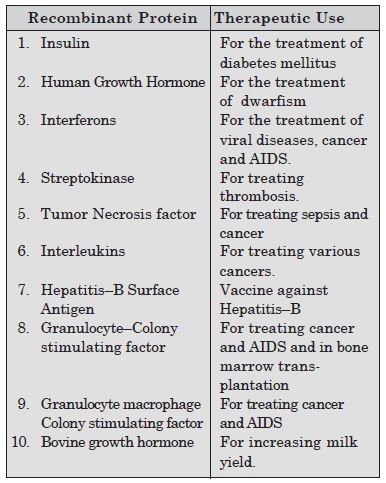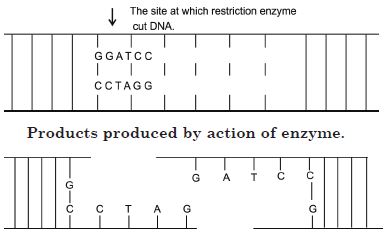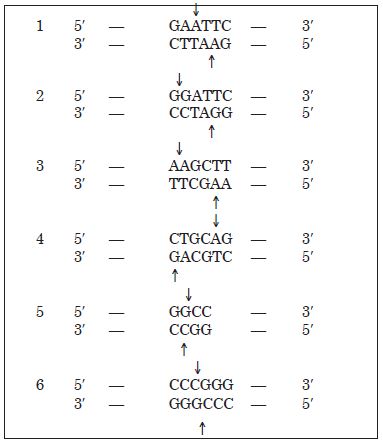Question 1:
Can you list 10 recombinant proteins which are used in medical practice? Find where they are used as therapeutics (use the internet).
Answer:

Question 2:
Make a chart (with diagrammatic representation) showing a restriction enzyme, the substrate DNA on which it acts, the site at which it cuts DNA and the product it produces.
Answer:
Action of restriction enzyme Bam HI.

Question 3:
Do eukaryotic cells have restriction endonucleases?
Answer:
Yes, eukaryotic cells possess restriction endonucleases. They are involved in editing (Proof reading) and DNA repairs during DNA replication. ‘‘Restriction Fragment Length Poly- morphism’ involve the use of restriction endonuclease.
Question 4:
Besides better aeration and mixing properties, what other advantages do stirred tank bioreactors have over shake flasks?
Answer:
Shake flasks are the conventional flask for fermentation studies during secondary screening
or laboratory process development. So, stirred tank bioreactors are used to produce the
product in large quantities. Besides aeration and mixing:
(i) it also helps in providing optimum growth conditions (temperature, pH, substrate, salts,
vitamins, oxygen) to achieve the desired product.
(ii) cost effective
(iii) due to baffles, oxygen transfer rate is very high
(iv) capacity of fermenters is more
Question 5:
Collect the examples of palindromic sequences by consulting your teacher. Better try to create a palindromic sequence by following base pair rules.
Answer:

Question 6:
From what you have learnt, can you tell whether enzymes are bigger or DNA is bigger in molecular size. How did you know?
Answer:
DNA molecules are bigger in size as compared to molecular size of enzymes. Enzymes are proteins. Protein synthesis is regenerated by small portion of DNA called genes.
Question 7:
Describe briefly origin of replication.
Answer:
(a) Origin of replication (Ori). 1. It is a specific sequence of DNA bases, which is
responsible for initiating replication.
2. An alien DNA for replication should be linked to the origin of replication.
3. A prokaryotic DNA has normally a single origin of replication, while eukaryotic DNA may
have more than one origin of replication.
4. The sequence is responsible for controlling the copy number of linked DNA.
Question 8:
Describe briefly bioreactor.
Answer:
Bioreactor. 1. They are vessels in which raw materials are biologically converted into
specific products using microbial, plant or human cells.
2. A bioreactor provides optimal conditions for achieving the desired product by providing
optimum growth conditions, pH, substrate salts, vitamins, oxygen, etc.
3. The commonly used bioreactors are of stirring type.
4. A stirred-tank reactor is usually cylindrical or with a curved base to facilitate the
mixing of the contents.
5. The stirrer facilitates the even-mixing and oxygen availability throughout the
bioreactor.
6. The bioreactor has the following components:
(i) An agitator system.
(ii) An oxygen delivery system.
(iii) A foam control system.
(iv) A temperature control system.
(v) pH control system and
(vi) Sampling ports.
Question 9:
Describe briefly downstream processing.
Answer:
Downstream processing. 1. It refers to the series of processes, to which a genetically
modified product has to be subjected before it is ready to be marketed.
2. The processes include two processes (i) separation and (ii) purification.
3. The product has to be formulated with suitable preservatives.
4. Such formulation has to undergo thorough clinical trials in the case of drugs. Strict
quality control testing is also required.
5. A proper quality controlled testing of each product is also required.
Question 10:
Explain briefly the PCR
Answer:
PCR—Polymerase Chain Reaction. It is the process in which multiple copies of the gene or
segment of DNA of interest are synthesised in vitro using cDNA and DNA polymerase.
Working Mechanism of PCR. A single PCR amplification cycle involves three basic steps;
denaturation, annealing and extension (polymerisation).
(i) Denaturation. In the denaturation step, the target DNA is heated to a high temperature
(usually 94oC), resulting in the separation of the two strands.
Each single strand of the target DNA then acts as a template for DNA synthesis.
(ii) Annealing (Anneal = Join). In this step, the two oligonucleotide primers anneal
(hybridize) to each of the single stranded template DNA since the sequence of the primers is
complementary to the 3' ends of the template DNA. This step is carried out at a lower
temperature depending on the length and sequence of the primers.
(iii) Primer Extension (Polymerisation). The final step is extension, wherein Taq DNA
polymerase (of a thermophilic bacterium Thurmus acquaticus) synthesis of the DNA region
between the primers, using
dNTPs (deoxynucleoside triphosphates) and Mg+2. It means the primers are extended towards
each other so that the DNA segment lying between the two primers is copied. The optimum
temperature for this
polymerization step is 72oC.
To begin the second cycle, the DNA is again heated to convert all the newly synthesized DNA
into single strands, each of which can now serve as a template for synthesis of more new
DNA. Thus the extension
product of one cycle can serve as a template for subsequent cycles and each cycle
essentially doubles the amount of DNA from the previous cycle. As a result, from a single
template molecule, it is possible
to generate 2n molecules after n number of cycles.
Applications of PCR.
1. Diagnosis of pathogen
2. Diagnosis of specific mutation
3. DNA fingerprinting
4. Detection of plant pathogens
5. Cloning of DNA fragments from mummified remains of humans and extinct animals.
Question 11:
Explain briefly the Restriction enzymes
Answer:
Restriction enzymes. 1. They are called ‘‘molecular scissors’’ or chemical scalpels.
2. Restriction enzymes, synthesized by microorganisms as a defence mechanism, are specific
endonucleases, which can cleave double-stranded DNA.
3. Restriction enzymes belong to a class of enzymes called nucleases.
4. They are of two kinds:
(i) Exonucleases, which remove nucleotides from the ends of DNA and
(ii) Endonucleases, which cut the DNA at specific positions anywhere in its length
(within).
5. The recognition sequence is a palindrome, where the sequence of base pairs reads the same
on both the DNA strands, when the orientation of reading is kept the same, i.e., 5' → 3'
direction or 3' → 5' direction.
e.g. 5' — GAATTC — 3'
3' — CTTAAG — 5'
6. Each Restriction endonuclease functions by inspecting the length of a DNA sequence and
binds to the DNA at the recognition sequence.
7. It cuts the two strands of the double helix at specific points in their sugar-phosphate
back bones, a little away from the centre of the palindrome sites, but between the same two
bases on both the strands.
8. As a result, single-stranded portions called sticky ends, are produced at the ends of the
DNA; this stickiness of the end facilitates the action of enzyme DNA ligase.
9. When cut by the same restriction endonuclease, the DNA fragments (of the donor as well as
the host/ recipient) yield the same kind of ‘sticky ends’ which can be joined end-to-end by
DNA ligases.
Question 12:
Explain briefly the Chitinase
Answer:
Chitinase. Enzyme is used in fungi to break open the cell to release DNA along with their macromolecules like RNA proteins, lipids and polysaccharides.
